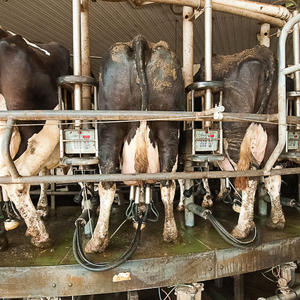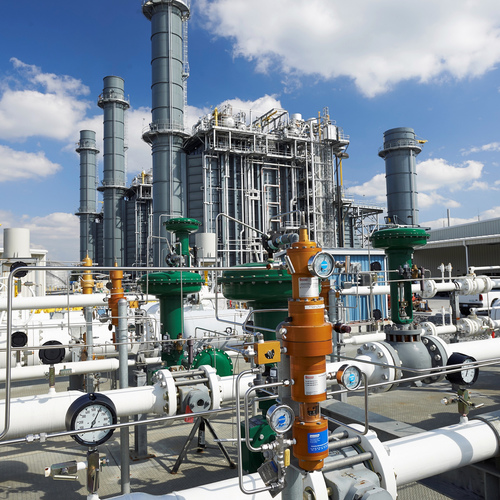
Natural gas is a versatile fossil fuel that accounts for about a third of U.S. energy use. Although it produces fewer greenhouse gas emissions and other pollutants than coal or oil, natural gas is a major contributor to climate change, an urgent global problem. Reducing emissions from the natural gas system is especially challenging because natural gas is used roughly equally for electricity, heating, and industrial applications.
There’s an emerging argument that maybe there could be a direct substitute for fossil natural gas in the form of renewable natural gas (RNG)—a renewable fuel designed to be nearly indistinguishable from fossil natural gas. RNG could be made from biomass or from captured carbon dioxide and electricity.
Based on what’s known about these systems, however, I believe climate benefits might not be as large as advocates claim. This matters because RNG isn’t widely used yet, and decisions about whether to invest in it are being made now, in places like California, Oregon, Washington, Michigan, Georgia and New York.
As someone who studies sustainability, I research how decisions made now might influence the environment and society in the future. I’m particularly interested in how energy systems contribute to climate change.
Right now, energy is responsible for most of the pollution worldwide that causes climate change. Since energy infrastructure, like power plants and pipelines, lasts a long time, it’s important to consider the climate change emissions that society is committing to with new investments in these systems. At the moment, renewable natural gas is more a proposal than reality, which makes this a great time to ask: What would investing in RNG mean for climate change?
This marketing video from Southern California Gas Co. promotes renewable natural gas as a climate-friendly energy option.
What RNG is and why it matters
Most equipment that uses energy can only use a single kind of fuel, but the fuel might come from different resources. For example, you can’t charge your computer with gasoline, but it can run on electricity generated from coal, natural gas or solar power.
Natural gas is almost pure methane, currently sourced from raw, fossil natural gas produced from deposits deep underground. But methane could come from renewable resources, too.
Two main methane sources could be used to make RNG. First is biogenic methane, produced by bacteria that digest organic materials in manure, landfills and wastewater. Wastewater treatment plants, landfills and dairy farms have captured and used biogenic methane as an energy resource for decades, in a form usually called biogas.
Some biogenic methane is generated naturally when organic materials break down without oxygen. Burning it for energy can be beneficial for the climate if doing so prevents methane from escaping to the atmosphere.
In theory, there’s enough of this climate-friendly methane available to replace about 1% of the energy that the current natural gas system provides. The largest share is found at landfills.
The other source for RNG doesn’t exist in practice yet, but could theoretically be a much larger resource than biogenic methane. Often called power-to-gas, this methane would be intentionally manufactured from carbon dioxide and hydrogen using electricity. If all the inputs are climate-neutral—meaning, for example, that the electricity used to create the RNG is generated from resources without greenhouse gas emissions— then the combusted RNG would also be climate-neutral.
So far, RNG of either type isn’t widely available. Much of the current conversation focuses on whether and how to make it available. For example, SoCalGas in California, CenterPoint Energy in Minnesota and Vermont Gas Systems in Vermont either offer or have proposed offering RNG to consumers, in the same way that many utilities allow customers to opt in to renewable electricity.
Renewable isn’t always sustainable
If RNG could be a renewable replacement for fossil natural gas, why not move ahead? Consumers have shown that they are willing to buy renewable electricity, so we might expect similar enthusiasm for RNG.
The key issue is that methane isn’t just a fuel—it’s also a potent greenhouse gas that contributes to climate change. Any methane that is manufactured intentionally, whether from biogenic or other sources, will contribute to climate change if it enters the atmosphere.
And releases will happen, from newly built production systems and existing, leaky transportation and user infrastructure. For example, the moment you smell gas before the pilot light on a stove lights the ring? That’s methane leakage, and it contributes to climate change.
To be clear, RNG is almost certainly better for the climate than fossil natural gas because byproducts of burning RNG won’t contribute to climate change. But doing somewhat better than existing systems is no longer enough to respond to the urgency of climate change. The world’s primary international body on climate change suggests we need to decarbonize by 2030 to mitigate the worst effects of climate change.
Scant climate benefits
My recent research suggests that for a system large enough to displace a lot of fossil natural gas, RNG is probably not as good for the climate as is publicly claimed. Although RNG has lower climate impact than its fossil counterpart, likely high demand and methane leakage mean that it probably will contribute to climate change. In contrast, renewable sources such as wind and solar energy do not emit climate pollution directly.
What’s more, creating a large RNG system would require building mostly new production infrastructure, since RNG comes from different sources than fossil natural gas. Such investments are both long-term commitments and opportunity costs. They would devote money, political will and infrastructure investments to RNG instead of alternatives that could achieve a zero greenhouse gas emission goal.
When climate change first broke into the political conversation in the late 1980s, investing in long-lived systems with low but non-zero greenhouse gas emissions was still compatible with aggressive climate goals. Now, zero greenhouse gas emissions is the target, and my research suggests that large deployments of RNG likely won’t meet that goal.![]()
Emily Grubert is Assistant Professor of Civil and Environmental Engineering at Georgia Institute of Technology. This article is republished from The Conversation under a Creative Commons license.
Weekly Newsletter
Get building science and energy efficiency advice, plus special offers, in your inbox.















19 Comments
You say that zero greenhouse gas emissions is the target, how is that even possible if natural gas is naturally occurring? Is natural gas not renewable? Where did it come from in the first place....fossils? If you believe that you better do some more research. If one can make RNG, as you call it, don't you think that the earth has the ability to make it's own gas? Is oil a naturally occurring and renewable substance or does it too require fossils to be made? What is oil and what is it's purpose? Where does natural gas come from and what is it's purpose? We only tap into these substances for our own use but is there a more natural use for it that the earth itself needs? Just like water, we use it but so does the earth and it recycles it to be used over and over again. Same with pretty much every other element or compound.......and without greenhouse gases we wouldn't have this wonderful greenhouse we live in.
“[Deleted]”
They shouldn't be swayed, instead they should investigate and learn for themselves....
WTF did I just read? The earth uses natural gas‽ Ken M would be proud of your trolling efforts.
Most appropriate use of the interobang(‽), I've seen in the wild.
If it didn't have a purpose....it wouldn't be here...
I'm honestly impressed by your efforts to troll here. Well, done.
Calcium, troll...what do you mean? Pleas explain yourself. I'm sorry if you can't understand my basic statement....what is your purpose here?
What the H does this article have to do with Green building?
I worked in the biogas industry from 2008-2013, I've always viewed it a waste treatment and methane control process primarily with energy generation as a by-process that (unfortunately, due to the way the world works) is financially critical to success. I was involved in the construction of one facility and the development of about a dozen that didn't move forward - the economics are very tight. I moved over to residential construction because it's more fun to build things than not build them.
Biogas capture and use is generally incentivized as part of a intersectional approach to pathogen reduction, waste management, odor reduction, BOD/COD reduction, and greenhouse gas reduction. Biogas cogen plants are built to help provide a funding mechanism for those benefits. If the government payed landfills and sewage treatment facilities and farms per ton of CH4 flared, they would just do that instead. The 'renewable natural gas' part of biogas projects isn't the important part! It's the methane destruction that's important!
If the author doesn't want biogas cogen because it threatens a transition to a 'hydrogen economy' or something, that's fine! However, decreasing methane emissions is an important world goal, and you'll need to propose a different way to incentivize it. Currently that's done by allowing biogas facilities to take advantage of renewable energy programs, and if you advocate against that the result will be more methane emissions, not cleaner energy. Just saying 'maybe biogas is not green energy' ignores the wider point of why it's classified that way in the first place - to incentive people into methane destruction, COD/BOD reductions, pathogen reduction, and odor reduction.
"Although RNG has lower climate impact than its fossil counterpart, likely high demand and methane leakage mean that it probably will contribute to climate change. In contrast, renewable sources such as wind and solar energy do not emit climate pollution directly."
That main statement as to why it's no bueno seems a bit weak, but what I've gleaned from it is that it's the leakage? Otherwise, It would just be an issue of comparing ROI's (both environmentally and economically) between something like RNG and an all electric scenario. Can we really say which has the batter ROI at this point? So it's the leakage...?
The researcher investigates a couple of scenarios: first - 'what if we capture and combust methane that would normally be released to the atmosphere' (obviously a net positive); second - 'what if all methane is already captured at baseline so the captured methane doesn't count for GHG reduction purposes but then some of the captured methane leaks into the atmosphere' (obviously a net negative since you go from 0% methane released to some amount more than 0%). The second scenario is the pivot point of the whole paper that results in 'biogas bad', but it's based on a super unrealistic starting point (100% capture).
I'm not sure what you mean by 'what if all methane is already captured at baseline'. But it sounds like you're describing case 3 of power-to-gas (not a captured gas, but synthesized), and so, yes, any release is net negative.
I guess what I find interesting is that the leakage is the main, and nearly only thrust presented here. I would have thought issues of ROI for the power-to-gas would potentially be a much larger hurdle than leakage. Power-to-gas would essentially be a form of storage, not production, and would involve both carbon capture and hydrogen production. Perhaps leakage really is the bigger strike against it, I don't know.
But the paper doesn't really answer that, as it specifies that it's scope is purely on leakage, and 'assumes' the other issues away with theoreticals:
"Further, to emphasize the particular challenge posed by methane leakage, this
analysis assumes RNG has no GHG intensity other than that associated with net impacts from methane leakage or destruction—that is, inputs to RNG production like electricity, hydrogen, and support infrastructure are assumed to be climate neutral. This assumption is consistent with the notion that zeroGHG electricity or hydrogen are potential alternatives to RNG. Note that because conversion processes are never 100% efficient, any GHG intensity for RNG associated with electricity or hydrogen inputs would exceed that of the electricity or hydrogen available for use."
Sorry, I was referring to 'path 2' and wasn't as clear as I could have been. In path 2 the model ignores all methane released prior to entering the flare (due to leakages upstream or just straight up un-captured releases at the point of generation). The model concludes that, because any further processing/transportation of methane already captured and 'flare-able' would result in additional leakage, therefore it's a net negative and should have just been flared instead.
In order to support the conclusion that biogas cogen is a net climate negative, the model ignores the vast majority of methane that is not controlled (either saying it is not capturable or, if it is capturable, arguing that it already should be captured so it doesn't count as a methane emission reduction). The model also ignores the fact that biogas cogen is largely used to support other environmental goals by providing a monetization avenue for waste treatment. No one sets up a landfill gas collection system and cogen plant to make money, they set it up to meet regulatory requirements related to landfill emissions and install a cogen plant to help defray costs.
Ya, I found that statement you quoted at the end a little odd. If you try to compare any 'conversion process' that isn't 100% efficient to a process that is 100% efficient (the theoretical 'zero-GHG electricity/hydrogen'), obviously the 100% efficient process will be more efficient. It's a tautology.
Thanks Sam. Makes more sense now. Enjoy your professional perspective.
One leakage people never consider is the plumbing vent pipe coming out of every building....
If you make methane from carbon dioxide and then burn it, aren't you then releasing the carbon dioxide? Presumably, carbon capture requires the CO2 to be sequestered, not burned. Or am I missing something?
Stephen,
The intent would not be to sequester the carbon long-term, but to store energy utilizing biogenic carbon, (thereby not releasing additional ancient carbon). It's really just a biofuel in this regard, and I think some scenarios (synthetic methane) actually include gasification of biomass.
Power-to-gas that involves the use of atmospheric carbon feels a bit different to me, in that it wouldn't get tangled up in the complexities (and much longer time-scales) of managing plant/forest growth. It seems it could be a possible storage medium for wind/solar generation.
And this ^(power to gas scenario) should not be confused with the currently more prevalent methane capture, where what would otherwise be released is methane, not CO2.
Emily needs to prove this: "natural gas is a major contributor to climate change", then we can go on from there.
Log in or create an account to post a comment.
Sign up Log in